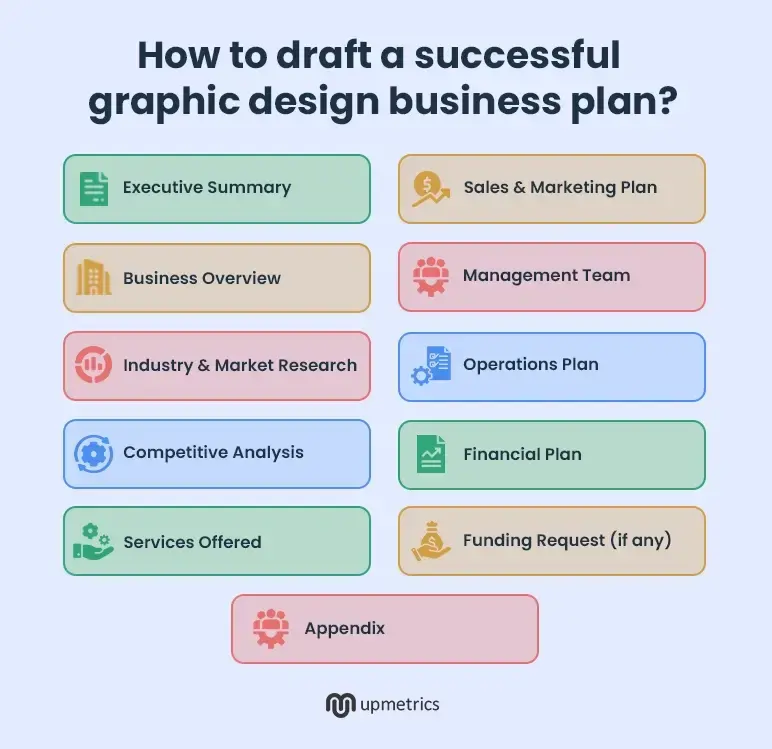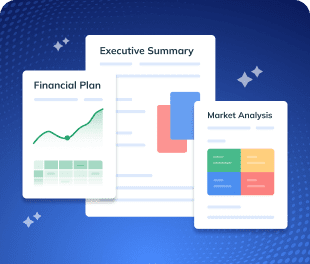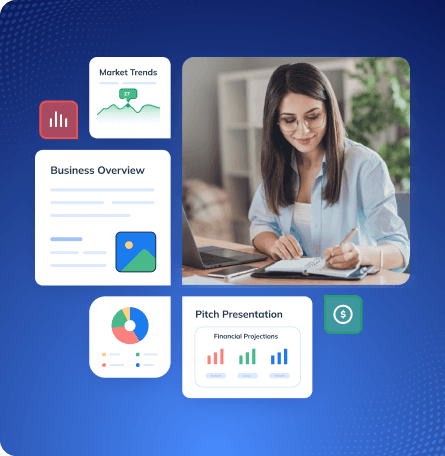You’ve been picking up design work when it comes. Maybe it started as a side hustle. Maybe it’s now your main focus.
Either way, you’ve got the skills, the clients, and a growing list of projects—and you’re ready to take it more seriously. Not just one-off gigs, but a real business.
The only problem: It’s a bit of a mess behind the scenes!
That’s where a business plan comes in. It keeps things clear, helps you stay on track, and makes it easier to run your business without second-guessing everything.
Not sure how to write a plan?
Don’t worry. This graphic design business plan template will walk you through the process.
Why do you need a graphic design business plan?
If you’re starting (or running) a graphic design business, having a business plan might seem like something only big companies need. But that’s not true at all.
A business plan helps you get clear on what you’re doing, who you’re helping, and how you’re going to make it work. It’s not just about goals—all written down in one place. It’s about giving your business some structure and direction.
Here’s why it matters:
- Stay clear about your goals: Instead of just taking any project that comes your way, a plan helps you stay focused on your ideal clients and how much you want to earn.
- Price and plan better: When you have a plan, it’s easier to set your prices, create packages, and figure out how many projects you need each month to reach your income goals.
- Track your money: A business plan helps you track what you’re spending on tools, marketing, and other costs—and how much money you’re bringing in from clients.
- Save time with clients: When your services, prices, and process are clear, you don’t have to explain everything from scratch each time. It makes the project work smoother.
- Look more professional: Having a plan shows clients and partners that you’re serious about your business. It even helps stay organized and ready to deliver good work.
In short, a business plan doesn’t just give your design business real structure, but also makes your daily work way easier and helps build something sustainable and truly profitable.
How to draft a successful graphic design business plan?
Here’s a quick, easy-to-follow guide to help you draft a successful graphic design business plan:

1. Executive Summary
Think of your executive summary as an elevator pitch—a clear snapshot of your graphic design business on one or two pages.
It’s the first section anyone reads, whether it’s a potential investor or a partner. It quickly tells them what your business is all about and why it’s worth investing in. So, keep it clear, concise, and compelling to grab their attention.
Here are a few basic questions you need to ask yourself while writing this section:
- What’s the registered business name and its legal structure? Where is it located?
- What services do you offer?
- Who are your target customers? And how do you help them?
- What makes you different from other designers?
- What are your future goals?
- Are you looking for funding? If yes, how much and what for?
Even though this plan summary appears at the top of your plan, try to write it last. Why? Because this will help you sum up all the essential elements you mentioned in the rest of your plan.
Say goodbye to boring templates
Build your business plan faster and easier with AI
Plans starting from $14/month

2. Business Overview
The business overview section provides a clear, detailed snapshot of your graphic design company—who you are and what your business stands for. It helps readers better understand your purpose, your setup, and your vision.
Here’s what you should consider including in this section:
Business name & type: Mention the name of your graphic design business and highlight the design style type of work you do (branding, web graphics, etc.).
Legal structure: What’s the legal entity of your business: a freelancer, sole proprietorship, or limited liability company (LLC)?
Location: Are you operating online, home office, a local office, etc.?
Ownership: Who owns the graphic design business? Are there any partners involved?
Mission statement: Write a short statement that describes your business’s core purpose, values, and what you promise to deliver to your clients.
Background history: Why did you start? Describe your “what got me into this” story?
Besides these key elements, outline your short-term and long-term goals. Are you aiming to go full-time, hire a junior designer, or launch a design course?
3. Industry and Market Research
The industry and market analysis helps you understand the external business environment in which your graphic design company plans to operate.
This section gives you valuable insights into the target audience, market demand, competitors, design trends, challenges, and growth opportunities.
While planning this section, consider including these details:
- Current industry size
- Market growth potential
- Emerging trends
- Target market
In addition to that, answer the following questions to better understand the demand for your services:
- Who your ideal clients are (startups, local businesses, bloggers, etc.)
- What kind of design help do they usually need (logos, social media posts, full brand kits)
- What they struggle with (DIY designs, inconsistent branding, no idea where to start)
You can also break down your key customer segments as shown in the table below:
| Customer Segment | Key Attributes | Needs and Preferences |
|---|---|---|
| Small Business Owners | New entrepreneurs and online sellers | Logo design, social media graphics, branding kits |
| Marketing Agencies | Outsource work to design partners | Fast turnaround, consistent quality |
| E-commerce Store Owners | Run product-based businesses | Packaging design, product mockups, banner ads |
| Content Creators / Coaches | Build personal brands online | Personal branding, YouTube thumbnails, infographics |
| Nonprofits and Local Groups | Budget-conscious, community-focused | Simple branding, event materials |
This shows you’ve done your homework and that you’re not going in blind. Also, it helps you get clear on who your audience is, what they expect, and how your business can serve them best.
4. Competitive Analysis
In this section, you’ll take a closer look at other graphic design businesses that offer similar services. This helps you understand how your business compares and what makes you stand out.
Start by identifying your competitors. Are they local design studios, freelance designers, or online platforms like Canva or Fiverr?
Look at their services, pricing, style, and customer reviews to see what they’re doing well and where they might fall short. Then, think about their strengths and weaknesses.
For example, a competitor might offer low-cost design packages but deliver generic work. Another might have great branding skills but take longer to complete projects.
By knowing this, you can figure out how to offer something better or different.
This will help you highlight your competitive advantages and explain what sets your business apart. These might include custom design solutions, faster turnaround times, a strong focus on brand strategy, or friendly, one-on-one client support.
Performing a SWOT analysis helps identify a business’s strengths, weaknesses, opportunities, and threats. It’s a simple tool to evaluate where the business stands and how it can grow.
5. Services Offered
This section outlines the core services your graphic design business offers. It helps define what your business can do and shows how your services are useful and relevant in today’s market.
You may offer one or more of the following design services:
| Category | Service | Description |
|---|---|---|
| Branding Services | Logo Design | Create unique and memorable logos that reflect the brand identity. |
| Brand Identity Packages | Develop a full visual brand system including colors, fonts, and brand guides. | |
| Rebranding | Refresh outdated brand visuals to align with new business goals. | |
| Marketing Design | Social Media Graphics | Design engaging visuals for platforms like Instagram, Facebook, and LinkedIn. |
| Print Marketing Materials | Design brochures, flyers, posters, and business cards for promotions. | |
| Email & Ad Creatives | Create graphics for newsletters, banner ads, and paid campaigns. | |
| Product Design | Packaging Design | Design eye-catching product packaging and labels for retail or e-commerce. |
| Merchandise Design | Create artwork for apparel, mugs, stationery, and other custom merchandise. | |
| Web & Digital Design | Website Graphics | Design custom visuals like banners, icons, and hero images for websites. |
| Presentation Design | Create visually appealing slide decks for pitches, reports, or webinars. | |
| Digital Templates | Build customizable Canva or PowerPoint templates for client use. |
Outlining your services, including a clear pricing strategy, helps potential clients, investors, or partners understand what you offer and how your design work supports business growth in different industries.
6. Sales and Marketing Strategy
This section explains how your graphic design business plans to attract new clients, encourage them to choose your services, and turn them into repeat customers.
Your sales and marketing approach should combine both online and offline efforts to showcase your work, connect with potential clients, and grow your business steadily.
Below are simple ways to get started:
Sales strategy:
- Offer free discovery calls to understand the client’s design needs and goals
- Provide flexible pricing or bundled packages for startups and small businesses
- Give excellent customer service by responding quickly, meeting deadlines, and offering revisions
- Share before-and-after design examples to show the value you bring
- Ask happy clients for testimonials and referrals
Marketing strategy:
- Use strong visuals and client success stories to show your work online
- Keep your website updated with a portfolio, service list, and contact form
- Use basic SEO and list your business on Google, Yelp, and local directories
- Post regularly on Instagram, LinkedIn, and Pinterest to share design tips
- Partner with web developers, marketing agencies, or business coaches for client referrals
Together, your sales and marketing efforts form the foundation for how your business will grow.
7. Management Team
A strong management team is key to running a successful graphic design business. This section introduces the people responsible for delivering services and keeping operations on track.
Even if it’s just you, say that proudly. Still give a quick summary of your background: how long you’ve been designing, what you specialize in, who you’ve worked with (even if it was just friends and family), and your strongest skills.
If you’re working with a small team, including a copywriter, virtual assistant (VA), or marketing assistant, explain their roles and what they bring to the table.
This will help you showcase to potential investors that the people behind your business are skilled and reliable.
To give more clarity, you can add a simple organization chart like the one below, showing who’s doing what and how responsibilities are divided across the team.
8. Operations Plan
The operations plan is about your day-to-day life as a designer, and how you keep things running without drowning in work or forgetting deadlines.
Here’s what to include in this section:
- Where do you work (home, café, shared office—doesn’t matter, just be honest)?
- What hours do you work, and when are you not available?
- What tools keep you on track (Google Drive, Notion, Trello, Adobe Suite, etc)?
- How do you handle projects? How will you start them, track progress, handle feedback, and send final files?
- How will you communicate with clients (email, calls, messages—pick what works for you)?
- How do you manage multiple projects without losing your mind?
Besides these operational aspects, write down how you’d handle a client project from the first message to the final payment. That’s basically your process. So, try not to overcomplicate it, just keep it simple and practical.
9. Financial Plan
Your financial plan is key to attracting investors and ensuring the long-term success of your graphic design business. It shows how you plan to make money, manage costs, and grow the business in a sustainable way.
Typically, the financial plan of graphic design includes actual projections for revenue, expenses, and profit over the next 3–5 years.
Here are the main financial statements and reports to include:
- Income statement (profit and loss)
- Cash flow statement
- Balance sheet
- Break-even analysis
- Risk management plan
You should also include rough estimates of startup costs and expected operating expenses. This will help you give a clear picture of your financial goals and how you plan to achieve them.
10. Funding Request (if any)
This section is all about how much money your graphic design business needs and why you need it. Keep it specific, realistic, and focused on essentials.
It also shows lenders and investors that you’ve carefully thought through your costs and have a responsible plan for how you’ll use the money.
You can even add a chart, as shown below, to give clarity on how the funds will be used.
Further, state the total amount of funding you’re seeking and where you plan to get it from. Possible funding sources might include:
- Personal savings and family contributions
- Small Business Administration (SBA) loans
- Traditional bank loans
- Private investors
- Crowdfunding campaigns
If you’ve already secured part of the funding, include that too. Showing a personal investment adds credibility and demonstrates commitment.
11. Appendix
Lastly, gather all the additional information or supporting documents that don’t fit into specific sections but support your business plan.
Consider adding the following things to your appendix:
- Legal documents (business registration, licenses, or permits)
- Copies of any contracts or agreements with clients or partners
- Resumes of the owner or key team members, highlighting design and business experience
- Sample marketing materials, such as social media posts or email templates
- Portfolio samples or links to completed design projects
- Customer testimonials or case studies that show positive results
In short, a business plan appendix helps keep your plan clean and organized while still providing important documents that lenders, investors, or partners may want to see. It also adds credibility by showing that you’re prepared and have proof to back up your ideas.
Download a free graphic design business plan template
Need help writing your own graphic design business plan from scratch? Worry not! Here you go—download our free graphic design business plan PDF to get started.
It’s a professionally designed business plan template created specifically for graphic designers, freelancers, and creative studio owners. Use this example as a reference while writing your own plan. You can also customize it to fit your services, style, and business goals.
The Quickest Way to turn a Business Idea into a Business Plan
Fill-in-the-blanks and automatic financials make it easy.
Conclusion
We’ve covered every essential section of a graphic design business plan—from defining your creative services and brand vision to outlining your operations, marketing strategies, and financial goals. You also got access to a free sample plan to help guide the process.
Whether you’re starting fresh or giving shape to an existing design business, having a clear, well-structured plan gives you the confidence to take the next step with purpose.
But if you’d rather skip the formatting hassles and focus on your creative work, Upmetrics can help. It’s an AI-powered business planning software that makes it easy to build a professional, detailed plan in less time. From market research to financial projections, it offers all the features to simplify planning.
So, don’t wait—give Upmetrics a try and bring your graphic design business vision to life!



